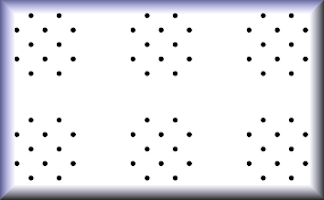

 |
 |
 |
 |
 |
 |
 |
 |
How many different sets of four dots
can be joined to form a square?

A printable sheet for student use is available here
Topics: Starter | Combinations | Puzzles | Shape
How did you use this starter? Can you suggest
how teachers could present or develop this resource? Do you have any comments? It is always useful to receive
feedback and helps make this free resource even more useful for Maths teachers anywhere in the world.
Click here to enter your comments.
Previous Day | This starter is for 12 April | Next Day
There is a printable worksheet to go with this activity.

Sign in to your Transum subscription account to see the answers
How many rectangles can be found by joining four dots on the grid?
How many triangles can be found by joining three dots on the grid?
How many polygons can be found by joining dots on the grid?
What are the areas of the polygons that can be found?
Assume that the horizontal and vertical distances between the dots
are one unit and the dots are symmetrically positioned.
|
Change the background of this page to
or
for clearer classroom display.
|
||

|
Teacher, do your students have access to computers such as tablets, iPads or Laptops? This page was really designed for projection on a whiteboard but if you really want the students to have access to it here is a concise URL for a version of this page without the comments: Transum.org/go/?Start=April12 However it would be better to assign one of the student interactive activities below. |
|
Here is the URL which will take them to a different type of counting activity.
Other shape counting starters:
How Many Squares 1?
| How Many Squares 2?
How Many Triangles 1?
|
How Many Triangles 2? | How Many Triangles 3?
How Many Rectangles?
| Rectangles Investigation |
Icosahedron |
Triangles in Hexagon |
Mystic Rose
Your access to the majority of the Transum resources continues to be free but you can help support the continued growth of the website by doing your Amazon shopping using the links on this page. Below is an Amazon link. As an Amazon Associate I earn a small amount from qualifying purchases which helps pay for the upkeep of this website.
Educational Technology on Amazon